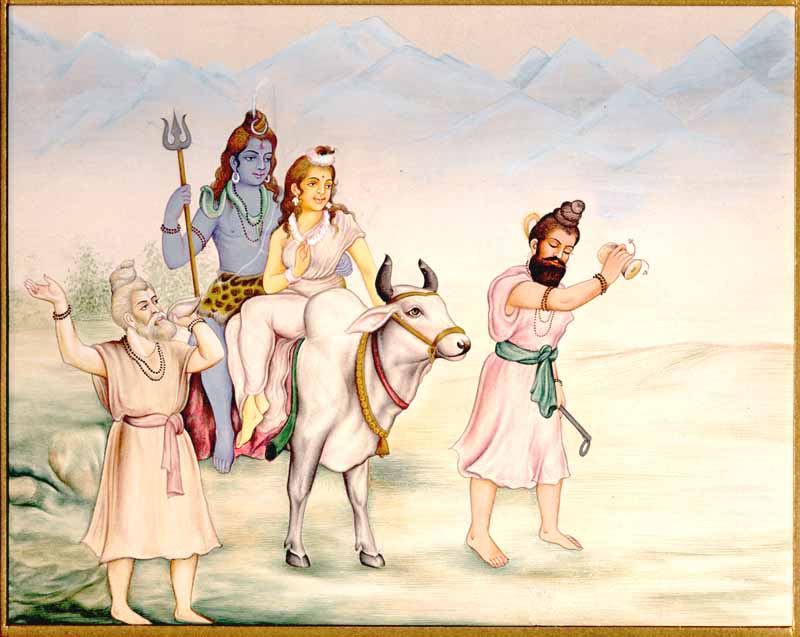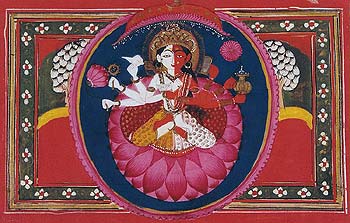By Acharya David Frawley (Pandit Vamadeva Shastri)
Tantra and Veda: One Tradition
Many writers, particularly in Western academia, have tried to divide the two great traditions of India of Veda and Tantra as different or even contrary. Some Yoga teachers have uncritically taken up this view.
Vedic and Tantric traditions are one, though with different orientations. The Vedic tradition is earlier and Tantra is one of its later developments, mainly through the Puranas. Tantric teachings abound in the use of Vedic mantras and the mysticism of the Sanskrit alphabet. They use Vedic fire rituals and and honor Vedic deities at an inner level. Inner Tantric Yoga reflects the four main Vedic deities of Agni, Soma, Vayu and Surya (the forces of fire, moon, wind and sun).
The main correlation between the Vedic and the Tantric is that whereas the Vedas emphasize the Jyotirmaya Purusha, ‘the Being or Person made of light’, the Tantras emphasize the Shaktimaya Devi, ‘the Goddess made of energy’. Yet light and energy as consciousness and force are one. The Purusha of light is one with its energy or Shakti. So the two traditions cannot be separated either. We could call the Vedic Yoga a ‘Vedic Light Yoga’ and the Tantric Yoga a ‘Tantric Energy Yoga’. The two are related historically and are complementary in their mantras and practices.
The Vedic view emphasizes the Shiva principle, though often under abstract principles of Brahman, Purusha and Atman, and in the form of Vedic deities (like Agni and Soma) which reflect the cosmic light form identified with Shiva. Yet the Vedas also recognize the Shakti principle as Vak or the power of the Divine Word, which is said to be the Veda-Mata or ‘Mother of the Vedas’. The Goddess pervades the Vedas as the Vedic mantra, though many feminine deities are also there and each Vedic God has his corresponding Goddess!
The Tantric view emphasizes the Shakti principle as the great Goddess but recognizes the light principle with Shiva as ‘Prakasha’ or pure illumination. Tantric Yoga also aims at the realization of Atman and Brahman, defined both as the light and energy of consciousness, Chid-jyoti and Chit-Shakti.
Human and Nature Images
Another difference between Vedic and Tantric Yoga is that the Vedic deities are first of all powers of nature like Fire, Wind, Sun and Moon. Their human forms or anthropomorphic sides remain vague. They are seldom portrayed in the form of a human figure. Tantric Deities, on the other hand, like Shiva and Shakti, are first of all anthropomorphic figures, with a human body, gestures and ornaments defined and delineated quite clearly and frequently. Yet Tantric deities have a deep nature symbolism with the Goddess and the mountain stream and Shiva as the mountain, for example, so this distinction is only general.
The Vedas center around four great Devatas (principles of light) as Agni (fire), Soma (water and moon), Indra-Vayu (lightning) and Surya (the Sun), as the inner and outer forms of light in the universe. Agni is the power of speech, mantra and the Divine Word. Soma is the power of the mind, meditation and Divine bliss. Indra is the power of perception, discrimination and direct realization of the higher Self. Surya is the supreme light of the Self and the power of life on all levels. Yet each of these forms of light has its corresponding forms of energy as fire energy, lunar energy, solar energy and electrical energy.
Tantric Yoga revolves around these same forces as Sun, Moon, Lightning and Fire. These forces appear as Goddesses in Tantra with Soma, the lunar reflective force, as the Goddess Lalita or Tripura Sundari and the crown chakra and the cosmic mind. Vedic Indra relates to Tantric Chinnamasta as the power of lightning perception in the eyes, the third eye. Surya is the solar power of life and awareness, the Self in the heart, which is Bhadra Kali among the Goddesses. Agni is the Kundalini fire in the root chakra, which is the Goddess Bhairavi and the ultimate power of speech. Vayu or Wind is the general Kriya Shakti force that is Kali in the broader sense as the cosmic Prana.
Both Vedic and Tantric Yogas teach how to awaken these four light and energy centers in the body. The fire in the three lower chakras (particularly the root chakra); the Moon in the three higher chakras (particularly the crown chakra); the Sun in the heart; and lightning working through the third eye as the general power of Shakti or energization. The Tantric Agni-Soma or Shiva-Shakti Yoga is another form of the Vedic Agni-Soma ritual on an internal level. Tantric Yoga which aims balancing Agni and Soma as Shiva and Shakti is a form of the Vedic Yoga.
Between Veda and Tantra on a practical level there is no real difference. Each has various levels of practices from the mundane to the transcendent, from rituals and mantras to formless meditation and Self-inquiry.
Shakti and the Vedas
The Vedic Rishis honored Shakti, which is primarily Vak Shakti or the ‘power of the Divine Word’. Their mantras are the manifestations of Shakti and carry the power of all creation and the secrets of cosmogenesis. The Rigveda itself is a creation of Kundalini Shakti, which is the power of Vak or Divine Speech, as it manifested at the beginning of this particular world age, but not merely in individuals but in great families of seers or Rishis. The Rigveda itself is perhaps the greatest mantric effusion of Kundalini Shakti at a collective level.
The Shakti of the Vedic hymns is the strongest of all Sanskrit hymns, reflecting the rhythms of cosmic creation and the thousand syllables of the crown chakra. Yet bija mantras like Hreem and Shreem are more defined in Tantra and the Tantric bijas are the strongest of all bijas, the primal sounds behind the universe. The Vedas reflect the metrical power of Sanskrit, whereas Tantra reflects the power of Sanskrit seed sounds.
Kashmir Shaivism, perhaps the most comprehensive Tantric philosophy, contains an elaborate system of relating the letters of the Sanskrit alphabet to all the cosmic principles from the Absolute to the earth element. It views the Sanskrit letters as the Shaktis and the Mothers (Matrikas) through which everything in the universe is energized.
The Vedic tradition contains a similar emphasis on the Sanskrit alphabet. According the Vedas generally, as in the Chandogya Upanishads, the vowels relate to Indra (Purusha) and the consonants to death (Prakriti). In the Aitareya Aranyaka the sibilants or s and h sounds are said to relate to Prana. This is a corner stone of the Kashmir Shaivite view as well. The great system of Kashmir Shaivism with its deities, mantras, pranas and tattvas reflecting the Sanskrit alphabet is a formulation of the older Vedic model.
Shiva, the Lord of Yoga
Shiva, if we look deeply, is the Supreme Deity of the Rigveda and its four main light forms as Agni, Soma, Surya and Indra (Vidyut). This statement may seem unusual, if not absurd, for those used to thinking that Vedas and Agamas are different or that Shiva is not a Vedic deity, because his name and form is not much present there. The problem is that such views only look superficially at the names and forms not to the inner content and energy of the Vedas.
Shiva is often called ‘Agni-Somatmakam’, meaning that ‘he has the nature of Agni and Soma’ as fire and water and all the other dualities that the two represent. Agni is his fierce or Rudra form. Soma is his blissful and linga form. Shiva is also regarded as Surya or the Sun, the pure light, Prakasha. As Prana, Shiva is also Vayu. He is Indra as the lord of perception and the power of mantra.
Shiva is the background deity of the Rigveda of which the other four main deities are but forms or manifestations. On one hand, they are facets of Shiva. On the other hand, they are like the sons of Shiva, which are his manifestations, with Rudra as the great father God in the Rigveda. The Vedic Yajna is itself the Tantric Yoga as an outer ritual, worship of the outer fire. Tantric Yoga is the Vedic Yajna internalized, worship of the inner fire of the Kundalini. The worship of Shiva maintains many Vedic forms of fire worship, use of Vedic mantras and communion with nature. Shaivites mark themselves with the sacred ash or Vibhuti from the fire. The Rudram, the most famous chant to Shiva, which is found in the Yajurveda, makes Shiva’s identity with the Vedic sacrifice very clear.
Note our books like Inner Tantric Yoga, Tantric Yoga and the Wisdom Goddesses, and Shiva: The Lord of Yoga, which address these issues.








